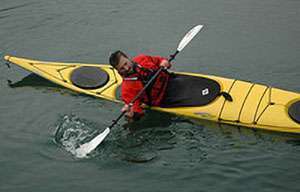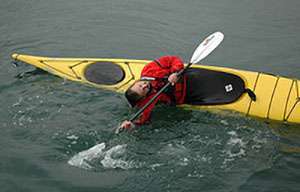While other strokes involve a catch and release point, sculling lets you get steady support from your paddle. The paddle dexterity that sculling teaches is also a very useful skill that will allow you to transition from one stroke to another smoothly, and help you to find support whenever you contact the water with your paddle.
The key to sculling is to keep your paddle moving back and forth, parallel to your kayak, and to maintain your blade on a ‘climbing angle’. A climbing angle refers to keeping the leading edge of your paddle blade higher than the trailing edge. This creates lift, making your paddle want to climb to the surface, generating support without the paddle sinking. For the sculling high brace, this means that you will cock your wrists back as you push your paddle forward towards your bow, and curl your wrists forward as you pull your paddle back towards your stern. With alternating strokes like this, you can get steady support from your paddle blade. As always, keep your arms low and your hands in front of you to protect your shoulder joints.



Sculling is usually practiced with the boat on a modest tilt, but an ‘extreme’ scull, where the paddler literally lies out on the water is a fun drill and a natural springboard to learning or perfecting the Eskimo roll.
For the extreme sculling high brace, lean back toward the stern deck and commit fully to the scull, allowing the buoyancy of your torso and pfd to help keep you floating at the water’s surface. This is actually far easier than trying to scull with your body just above the water. When floating, only a light scull will be necessary to maintain the position.
Point your chest at the sky and stretch from the waist, rotating your torso in order to keep the kayak as upright as possible. Concentrate on keeping your inside knee pointing upward to prevent the kayak from overturning.
To finish the extreme scull and right the kayak, your body, not your blade, will do most of the work. As you sweep your paddle from the bow toward the stern, drive your inside knee up—completely righting the boat—and draw your ribcage in laterally over the kayak, with your head coming up over the boat last. Leaning back over your stern deck is easiest. Remember that your head comes up last, as lifting your head too early will make righting the kayak a real struggle.

